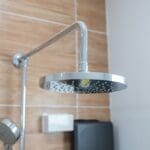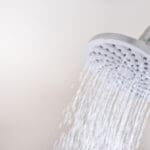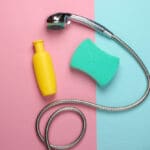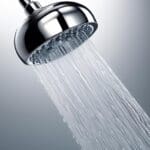You might not realize it, but your shower head can be a breeding ground for bacteria and mold, impacting not just the water pressure but also your health. To tackle this, you’ll need a few simple tools: heavily distilled white vinegar, a soft bristle toothbrush, and some patience.
Key Takeaways
- Gather cleaning supplies including heavily distilled white vinegar, mild cleanser, toothbrush, and bowl.
- Remove shower head, inspect for debris, and scrub thoroughly.
- Reattach shower head, test water flow, and maintain for optimal performance.
Gather Your Cleaning Supplies
Before diving into the cleaning process, let’s gather the necessary supplies:
- a mild cleanser
- heavily distilled white vinegar
- a soft bristle toothbrush
- a large bowl
- optionally, a large zip-tie bag
You’re also going to need a few more items to tackle those stubborn hard-water stains and ensure a thorough clean:
- baking soda
- a plastic bag big enough to cover the showerhead
- a rubber band to secure it
- a microfiber cloth for wiping down
- an old toothbrush for scrubbing the nooks and crannies
If you’ve got lemon juice, it’s a great natural alternative to harsh cleaning products. Keeping these items in a storage bag will make your next cleaning session hassle-free.
Mixing white vinegar and water in a bowl or plastic bag creates an effective soaking solution that breaks down mineral buildup. For tougher stains, adding baking soda to the mix can provide that extra scrubbing power. Using lemon juice in place of or alongside vinegar can help dissolve grime while leaving a fresh scent.
This arsenal of cleaning supplies will make your shower head sparkle like new and keep those hard-water stains at bay.
Remove the Shower Head
Removing the shower head starts with loosening it at the base of the arm using an adjustable wrench. Once it’s detached, inspect it for any loose debris on the outside and peel off sealant tape stuck to the threading. If you notice minor clogs in the small screen or flow restrictor, gently remove these using needle-nose pliers.
Next, rinse the showerhead thoroughly. For a deep clean to tackle calcium and mineral deposits, place it in a bowl that allows it to be completely submerged in a solution of equal parts heavily distilled white vinegar and water. This vinegar soak is a tried-and-true cleaning hack that works wonders. If there’s stubborn buildup, use a toothpick to carefully dislodge any remaining debris. Let the showerhead soak to ensure the vinegar has enough time to dissolve all the mineral buildup.
Soak in Vinegar Solution
After detaching and rinsing your shower head, it’s time to submerge it in a heavily distilled white vinegar solution for a thorough clean. Start by filling a large bowl with equal parts distilled white vinegar and one part water. This mixture is your key to effectively cleaning with vinegar, targeting the stubborn mineral buildup that often plagues shower heads.
Once you’ve prepared the solution, remove the shower head from the arm. Carefully place it into the bowl, ensuring it’s completely soaked in the vinegar solution. For those hard-to-remove heads or when you prefer not to dismantle, a vinegar-filled bag secured with rubber band(s) around the fixture works just as well. This method allows the shower head to soak in vinegar solution without the need for removal.
Scrub and Rinse Thoroughly
Once you’ve rinsed the shower head post-soak, it’s time to tackle any remaining mineral deposits with a soft bristle toothbrush. This step is crucial in your deep clean process to ensure that every nook and cranny of your showerhead is free from buildup, restoring its water flow to optimal condition.
When you scrub and rinse thoroughly, follow these steps for effective results:
- Gently Scrub: Use the toothbrush to gently scrub around the nozzles and any other areas where deposits are visible. The bristles should be soft enough not to scratch the surface but firm enough to remove buildup.
- Rinse with Warm Water: After scrubbing, rinse the shower head with warm water to wash away loose debris. This helps to ensure that all the efforts of soaking in a solution of parts distilled white vinegar and water aren’t in vain.
- Repeat if Necessary: If you notice that some deposits are stubborn, repeat the soaking process for a couple more hours and then scrub again.
Incorporating this scrub and rinse thoroughly step into your shower head cleaning routine guarantees a cleaner, more efficient showerhead. Remember, a clean shower head not only improves water flow but also contributes to a healthier shower environment.
Reattach and Test Flow
With your shower head thoroughly cleaned, it’s time to reattach it and check the water flow for improvements. Start by ensuring all parts are dry and clean. Carefully screw the shower head back onto its fixture. Make sure it’s tight enough to prevent leaks but not so tight that it damages the threads.
Before you turn the water on, take a moment to ensure that the shower head is securely in place. This is crucial to avoid any surprise mishaps when the water starts flowing. Once you’re confident it’s securely attached, slowly turn on the water. This gradual approach helps you spot any immediate leaks around the connection.
As the water flows, observe the water pressure. A noticeable improvement in pressure indicates a successful cleaning. If you soaked your showerhead in a cleaning solution, this step is where you’ll truly see the fruits of your labor. The water should flow evenly from all nozzles, a sign that any buildup inside the shower head has been effectively removed.
Now that you know how to clean and reattach your shower head, maintaining it should be a breeze. Regular cleaning will ensure your showers are always pleasant, with optimal water pressure and flow.





